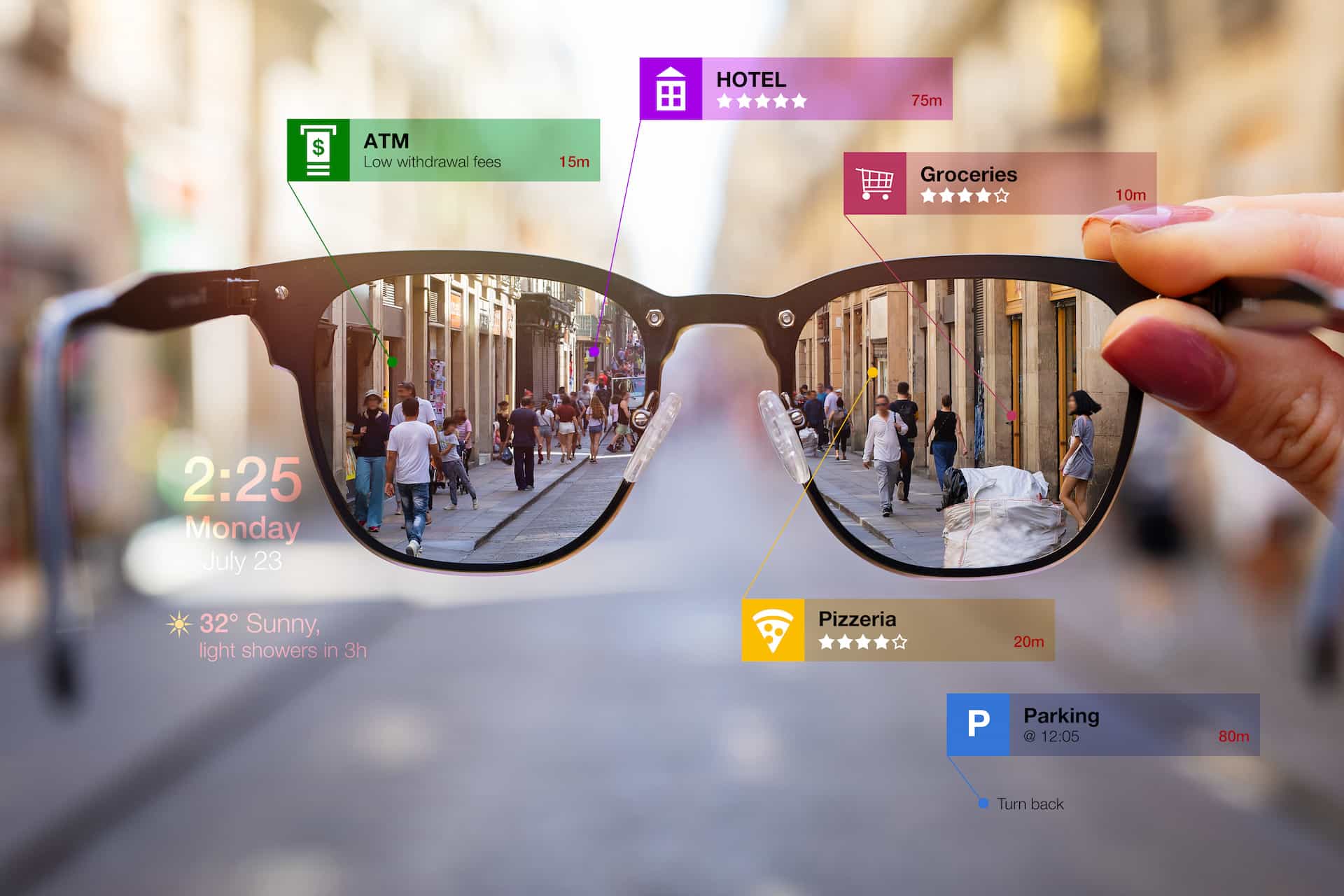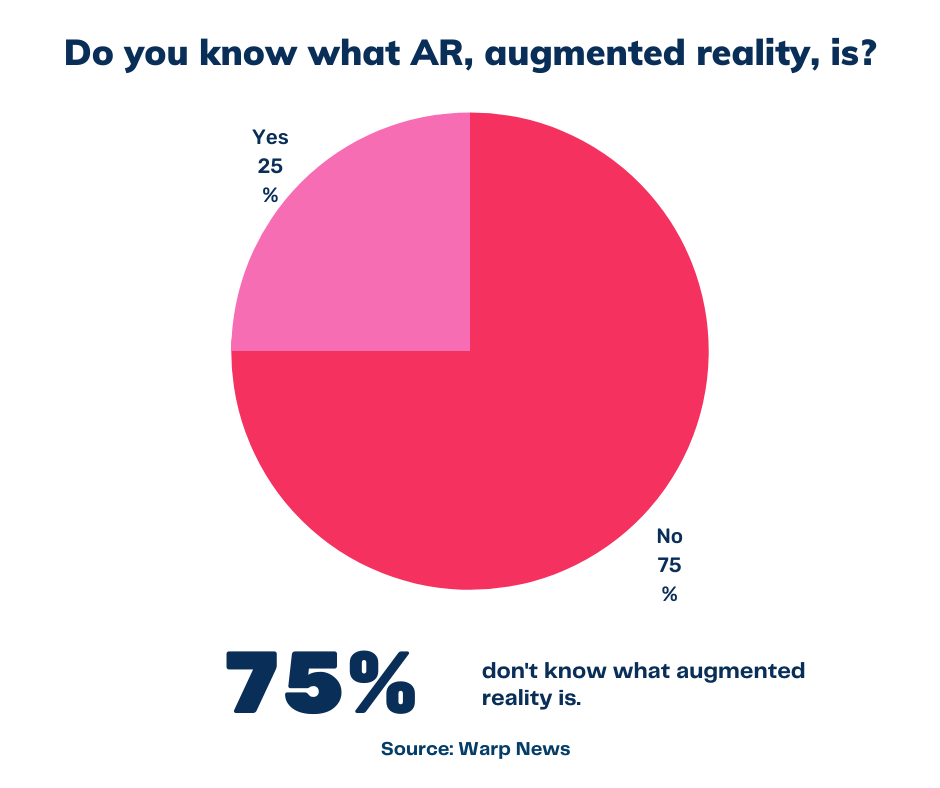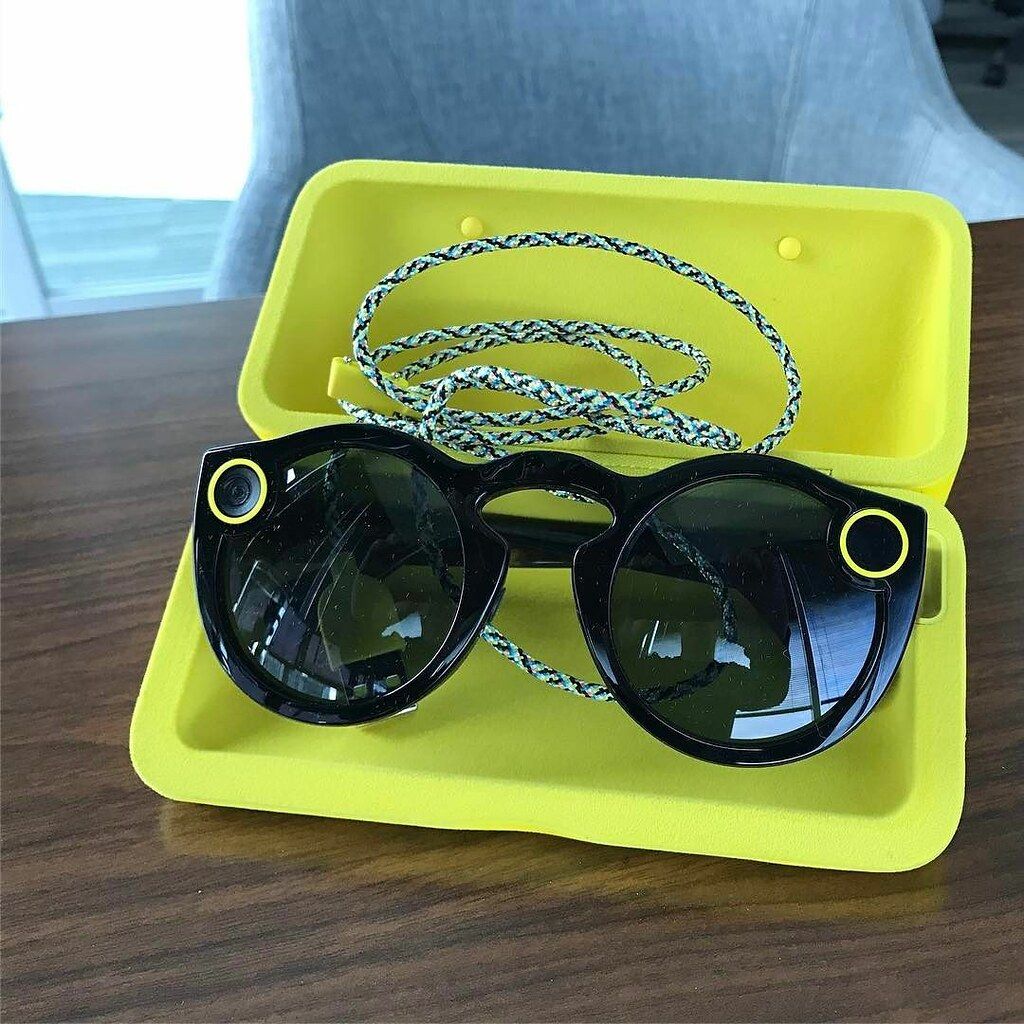
💡 Optimist's Edge: The glasses that will help you learn
Construct machines as a service technician, decorate your house as an interior designer, or paint as an artist. Soon, AR glasses will allow you to become an expert in areas you previously did not even dare to go try out. Despite this, most people do not even know what AR (Augmented Reality) is.
Share this story!
Summary
📉 What people are wrong about
3 out of 4 respondents in our survey do not know what AR, augmented reality, is and therefore do not know the potential of the technology.
📈 Here are the facts
Millions of people are already using various AR services and applications in their smartphones – even though a large proportion of them do not know that it is AR.
In general, all the major global tech companies are investing heavily in the development of AR glasses and AR platforms. Market analysis companies predict a sharp increase in the number of AR glasses sold in the coming five years.
💡 Optimist’s Edge
The AR technology itself, the glasses and the necessary surrounding infrastructure have reached a matureness and can be used by individuals and companies.
5G and industry standards such as WebRTC, have created an opportunity for
lightning-fast transmissions in real time. AR via glasses instead of mobile devices, gives the user a significantly smoother and more naturally intuitive experience – something that will greatly increase the attractiveness and interest in AR. This will drive increasing the demand for new AR services and applications in a number of different areas.
There are a lot of different areas and industries that will benefit greatly from AR technology and AR glasses will be used for both pleasure and more practical purposes. The AR glasses can be used to get deeper cultural experiences as well as in industrial assembly. The technology can be handy in interior design and furnishing, as well as in educational contexts. The potential of AR is virtually unlimited by its nature.
👇 This is how you get the Optimist’s Edge
Consider an investment in innovative AR startups. Even though not all startups will end up developing the units themselves, some will be acquired by the tech giants – or enter partnerships. Both of these usually mean that you have made a good investment.
Examine which parts of your company's business that could be enhanced by the technology. Invest early in the technology and dare to take the leap.
Dig into and get familiar with the framework and capabilities of the AR infrastructure and the software solutions that can support AR technology. What platforms and scalable solutions will there be a demand for? Is there anything you could do today, to take a step in the right direction?
Find out which components, accessories and peripherals will be needed when the technology gains attraction. Selling picks and shovels during a gold rush is often a profitable choice.

📉 What people are wrong about
3 out of 4 respondents in our survey do not even know what AR, augmented reality, is and thus do not know the potential of the technology. The vast majority can look forward to, literary, seeing the world as they know it change in front of their eyes.

📈 What the facts say: This is why AR glasses are the future
Augmented reality, or AR, is reality that is not fully constructed, like Virtual Reality, but a technology where our actual reality is amplified or changed in different ways when we look at it through, for example, mobile devices or connected smart glasses.
The technology can be used for a variety of purposes, from giving additional dimensions to gaming, shopping and cultural experiences, to instructing and helping people learn new things.
In recent years, AR technology has become an increasingly natural part of many services we use in our mobile devices, from games such as Pokemon Go to IKEA's service for trying out furniture at home.
In our everyday lives, AR can help us cook like a master chef, carve our own furniture or draw and paint like a master without prior knowledge. And this is just a few examples of what AR could achieve.

In professional contexts, there are also many smart applications, for example to train or help new workers who do repairs, installations and assemblies. In the construction industry, AR can be used in several critical operations and in educational contexts the technology can be used to deepen the experience during practical scenarios like when experimenting with material and substances without actually needing the physical materials.
One of the overall benefits of AR-based education is of course, that students can access educational exercise materials and information anytime, anywhere – without having to carry a bag full of books or a laptop. And when AR fully shifts to glasses, even more opportunities open up and we will see a new era of easily accessible and inclusive digital learning.
Delivering AR experiences via smart glasses has been a technology in the making for quite some time now – and has long been pointed out as the "next big thing" for our mobile lives.
As early as 2014, Google began selling the first version of its smart glasses, Google Glass, to the public. Compared to what can be built today, the first version was a relatively simple unit. However, it received a lot of attention and was tested, for example, in healthcare, amongst journalists and during concerts. At that time, however, the infrastructure around AR technology was not mature enough for the glasses to be become the overnight success that many predicted.
But since then, of course, a lot has happened and the technology on all levels has evolved. Google has released new versions of its glasses, and the latest version "Google Glass Enterprise Edition 2" is, as the name suggests, designed
specifically for professional use.

Tech giants are leading the race
Most of the other global tech giants have also already hopped on the AR train.
Facebook's CEO Mark Zuckerberg hyped AR glasses back in 2017, during the F8 Developers Conference in San Jose, and after several years of development work the social giant is now expected to release its own AR glasses soon.
In mid-September 2020, during Facebook Connect – the AR/VR event formerly known as Oculus Connect – Zuckerberg confirmed that Facebook has partnered with fashion glasses giant Essilor Luxottica to create designer smart glasses that will be launched under the iconic Ray-Ban brand. In early 2021, Andrew Bosworth, Facebook's head of AR/VR development, announced that the company's first AR glasses will be unveiled sometime this year, and in late April 2021, Mark Zuckerberg said:
"I believe that augmented and virtual reality are going to enable a deeper sense of presence and social connection than any existing platform. And they're going to be an important part of how we will interact with computers in the future. So we're gonna keep investing heavily in building out the best experiences here. And this accounts for a major part of our overall R&D budget growth."
In late May, Snap, the company behind the social network Snapchat, launched the fourth version of its Spectacles glasses. Unlike the company's previous smart glasses, which had built-in cameras but did not deliver "real AR", the new Spectacles glasses project virtual images of "reality" directly in front of the wearer.
The device has a small touchpad at the frame hinges, two cameras, four microphones, stereo speakers and is powered by a chip that is specially adapted for AR and VR. The glasses have not yet been released to the public, but they have been distributed to a selected group of global creators and developers in the AR community, and they are available to "qualified buyers".

Snap has also announced that they plan to invest approximately US$ 364,000 in a new AR innovation lab ,with additional support of just over US$ 100,000 from Verizon, to develop new 5G-based AR experiences.
Persistent rumors say that Apple will also launch its first glasses in the near future – the rumors grew after Apple acquired several AR companies, entered into a partnership with a manufacturer of mini OLED displays and also registered a patent for AR glasses.
Apple and Google also offer their own open source-based development kits: ARKit and ARCore, which at the end of 2020 had 950 million and 122 million active users, respectively. At the same time, there were close to a total of two billion units, smartphones and tablets, running ARKit or ARCore.
All over the world, technology companies, from startups to giants, are investing considerable resources in the development of AR glasses for consumers. It is believed to be the next big technology platform after the smartphone and kick off a whole new way for consumers to use mobile technology.
In addition to the big tech giants, there are a plethora of startups that have received significant investments to develop their visions of the AR glasses of the future.
💡 Optimist’s Edge
As described above, AR is already used in services in our smartphones, but the functionality of these services is often far from optimal – being forced to hold up a phone interferes with, and lowers the AR experience. And not to forget, the phone occupies one of the user's hands and also requires the phone to be held correctly and at the right angle.
With glasses, there will be a much more natural interaction between the user and the technology. AR via glasses is simply a superior experience, compared to viewing simulated objects via the camera in a smartphone. People have generally become more accepting of portable technology that enhances the experience of reality, and also more inclined to integrate these solutions into everyday life.
At the same time, thinner and higher resolution screens and lenses, more powerful processors and increasingly in-depth software makes the AR experiences more and more convincing. Its impossible to mention all the possibilities and potentials of AR glasses in the realm of this article, but some of the possibilities are:
- Deepening the gaming experiences through integration of the physical surroundings
- Solutions that help retailers enhance the shopping experience
- Map and navigation support
- Remote assistance with assembly and interactive manuals
- Adding more dimensions to cultural experiences and events
- Education, both for better remote education and to simplify or deepen specific teaching elements

Today, the majority of AR glasses already on the market are aimed primarily at professional and industrial users, rather than consumers. For example, Microsoft has entered into a giant agreement with the US military to build and support customized versions of its HoloLens headset.
But, given that basically all the big tech giants, with their massive financial muscles, are investing heavily in AR glasses, while 5G is now being rolled out around the world, we will very likely see a rapid development and widespread adoption of AR glasses. The phenomenon might not be to dissimilar to the development of smartphones and smartwatches.
Although many people currently do not know what AR is or what possibilities the technology brings, most people will regularly use AR in various forms in the future.
They will use it in their smartphones, or better yet: in their glasses. The adoption of AR glasses for the consumer market is expected to be relatively slow in the beginning, and analysts estimate that early versions will cost about as much as a new smartphone in the premium segment, which can be up to US$ 1,211.
But when AR glasses reach a combination of being both comfortable, affordable and socially accepted, AR's importance will skyrocket. It's not unlikely that AR glasses will play a key role in the tech industry.
High growth is excepted
The growth can to some extent be predicted by looking at the gradual increase in sales of Facebook's VR headset Oculus – one of the best-selling VR devices.
According to the market analysis company IDC, 3.5 million Oculus headsets were sold globally in 2020, which is a significant increase from the 400,000 units sold in 2016 when the glasses were launched. IDC predicts that less than one million AR glasses will be sold in 2021, but expects strong growth in the coming years to reach 23.4 million units sold in 2025.

According to MarketsandMarkets, the AR technology market is currently worth $15.3 billion, and will exceed $25 billion as early as 2025. ARtillery Intelligence expects that the AR glasses market alone will grow from $822 million to $13.4 billion by 2024.
The adoption to 5G worldwide will help accelerate the development and demand for AR solutions. In Gartner's "5G Enterprise Study", AR and VR applications are pointed out by the respondents as the area were they have the highest expectations of future revenues.
5G can support several different applications, such as real-time high-definition video rendering, shorter download and installation times, and more advanced and interactive user experiences. Gartner also predicts that in 2022, consumers will spend over $93 billion on so-called wearables and smart portable devices, which is a doubling compared to 2019.
In summary, we are facing a spectacular revolution and before we turn to the first page of 2025 in the almanac, there will be at least a handful of high-performance AR glasses available in the consumer market. They will not cost more than a premium class smartphone and we will use them for a variety of purposes.
Above all, in many areas they will be an even more practical and intuitive helper than our phones, and they will help us become experts in almost anything we want.
👇 This is how you get the Optimist’s Edge
Even though the market is currently teeming with start-ups with their own variants of AR glasses, it is still highly probable that the market will ultimately be dominated by the tech giants, due to their almost unlimited resources to invest in research and development.
Like the market for smartwatches or smartphones, we will therefore hardly see a diversified market with many small players and startups, rather, innovative start-ups within AR will be acquired by the giants. Apple, for example, has already bought several AR companies, which certainly can make start-ups a good investment opportunity.
What could be a more dynamic and interesting market is that for various services, applications and platforms – not least niche and industry-specific solutions. Here, it can really pay off to quickly start developing scalable solutions specifically for glasses.
If you want the benefit of being an early adopter it might be a good idea to start investigating which parts of your business that could be adapted for an AR experience. Many things will be easier to manage via AR experiences, such as different types of remote education and support functions. If you start now you will save money, due to the fact that you can cut costs with AR, and you will
win customers' trust as an innovative and future-oriented player.
It is also smart to create an insight into how glasses are built. What components and materials will be needed? In addition: given that AR glasses will be something the user wears visible, it will be of great importance that they look good, purely in terms of design. Therefore, it is highly likely that – just like with ordinary glasses – there will be a demand for designer frames and protective cases.
It may also be worthwhile to investigate what other peripheral products will be in demand, keep in mind the global market for mobile cases for instance. Are different types of charging stations needed? Lens cleaners? Headphones? Other portable accessories?
Finally, there will also be a great need for digital creators, in the form of artists, illustrators, animators, speaker voices and storytellers who can all contribute to creating as good AR experiences as possible in all genres and languages. If you are already working with digital creation, it is therefore a hot tip to familiarize yourself with how you can use your talents to create the AR experiences of the future.
❓ Share your thoughts with us on social media.
We are building a library of optimistic edges, exclusive for our Premium Supporters.
Note: Claims in this article do not constitute financial or investment advice. Always do your own research before investing.
By becoming a premium supporter, you help in the creation and sharing of fact-based optimistic news all over the world.


